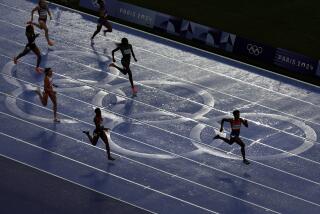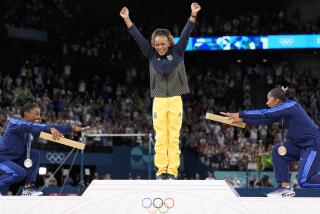Trying to stay ahead of the game
- Share via
Call it dopers vs. testers, Beijing edition.
With 11,000 athletes converging on China in the coming days, the International Olympic Committee plans to collect 4,500 blood and urine samples before and during more than two weeks of athletic events -- a 25% increase from the 2004 Athens Games. Officials will check more than 400 athletes for synthetic human growth hormone, focusing on competitors in track and field, cycling, swimming and weightlifting.
It’s the latest lap in the race between those using illegal performance-enhancing drugs and those who seek to stamp them out. Anti-doping officials express hope that a combination of sophisticated detection techniques, frequent testing and old-fashioned shame will keep these Games comparatively free of drug cheating.
“This is of course a cat-and mouse game, but for the first time the cat will be at the same level as the mouse,” Dr. Patrick Schamasch, the IOC medical and scientific director, told reporters Thursday in Beijing. “And I do hope the cat will be waiting for the mouse outside the hole.”
Yet doping remains a major headache for the Olympics, 20 years after it burst into the open when Canadian sprinter Ben Johnson was stripped of his gold medal for steroid use.
Five female members of Russia’s Olympic team were suspended Thursday by the international governing body for track and field, which accused them of a decidedly low-tech offense, the “fraudulent substitution of urine which is . . . a form of tampering with the doping control process.”
The athletes include gold medal favorite Yelena Soboleva, who set an indoor world record earlier this year in the 1,500 meters, and two-time world 1,500-meter champion Tatyana Tomashova.
In other cases, American swimmer Jessica Hardy, 21, of Long Beach, is appealing what her attorney calls a “low positive” test for the banned diet drug Clenbuterol, and still hopes to compete in China, while Jamaican sprinter Julien Dunkley, 32, was dropped from his team this week after officials confirmed that a Jamaican sprinter had tested positive for the muscle-building veterinary drug Boldenone.
Bulgaria withdrew its entire weightlifting team last month after 11 athletes tested positive for steroids, and 11 Greek weightlifters were suspended for doping. Host China banned two would-be Olympians for life, a swimmer who allegedly tested positive for Clenbuterol and a wrestler accused of using a drug-masking diuretic.
Anti-doping officials are optimistic that the blood test for HGH, which was administered on a limited basis in Athens but detected no cheaters, can withstand legal challenges.
“We won’t put a test out there if we’re not ready to defend it,” said David Howman, director general of the World Anti-Doping Agency.
Still, some sports doping experts worry that as-yet unimagined forms of cheating will take place in Beijing.
“Every year, we think the labs and the testing are getting better, but then along come the Olympics and we find things we never expected,” said Don Catlin, who operates the Los Angeles-based Anti-Doping Authority and will help supervise the HGH test. “It’d be lovely to have no positives, but that’s not likely to happen. And even if there are less positives, you wonder, is it because we’re doing a better job, or because they’ve found something new?”
Testers have faced pointed criticism in recent weeks from none other than BALCO founder Victor Conte, who says athletes still have numerous ways of beating the system.
Conte, who served four months in prison for steroid distribution and money laundering, says athletes are able to avoid detection by blocking their cellphone numbers or spending the night with friends or relatives. Because athletes may miss two drug tests in any 18-month period, Conte said, “You can still have two strikes and hit a home run.”
Conte said athletes can use red blood cell-boosting Erythropoietin (EPO) intravenously, knowing it will clear rapidly from the system -- as quickly as a day. Others can skirt punishment altogether with the legal, and contentious, use of oxygen-increasing tents and masks that can simulate the effects of EPO.
Conte said athletes have taken advantage of a reduction in out-of-competition testing in the fourth quarter of 2007 by both the U.S. Anti-Doping Agency and the International Assn. of Athletics Federation.
“It’s that off-season training, this strength base, that serves them months later during the competitive season,” Conte said. “So, it tells me athletes aren’t going to be using now, around the Olympics. They were using when there was no testing.”
Travis Tygart, USADA’s chief executive, downplayed the reduction of testing. “Volume is something to be considered, but it’s not the magic formula,” Tygart said. “It’s about quality over quantity.”
While Conte says he “applauds” Tygart’s overall efforts, he said testers can do better at outfoxing the cheaters.
“There needs to be quality in testing, targeting. The top 20 athletes in the world from any event need to be targeted, but ask Travis who he caught in that quarter: Try nobody,” Conte said. “That [reduction] needs to be scrutinized, and it’s highly suspect. It’s either ignorant, or it’s enabling drug use.”
Tygart dismisses the criticism. He takes pride that drug-linked Olympians such as Conte’s former clients Tim Montgomery, Marion Jones and Kelli White and coach Trevor Graham, along with sprinter Justin Gatlin, have ultimately been exposed, forced to return Olympic medals, or banned from competition.
Tygart and WADA’s Howman say there’s deterrence value in the stories of the imprisoned Jones being stripped of her 2000 Games medals and the overturned Tour de France victory of cyclist Floyd Landis.
“Living life as a fraud is not the way an athlete wants to live,” Tygart said. “They lived miserable lives, knowing every time they showed off their medals they had stole them.”
Howman said the expensive Landis defense that failed “shows athletes you shouldn’t throw down the legal gauntlet; that game’s been played and lost now.”
For these Games, Tygart has requested that all U.S. athletes join USADA’s “My Victory” campaign, pledging to compete drug-free in China. Among those who’ve made the pledge are swimmers Dara Torres and Michael Phelps and sprinters Tyson Gay and Allyson Felix.
Torres’ feats as a 41-year-old, record-setting swimmer have raised suspicion.
“It’s an unfortunate climate created by a few dirty athletes, but prior to any other evidence, good performances in old age is not evidence of doping,” Tygart said. “ . . . The world should take great comfort in the knowledge that our U.S. athletes are held to the most sophisticated testing program in the world.”
However, the “nagging thought,” as Catlin describes it, is that Jones came back clean after taking more than 100 tests during her international track career. She didn’t admit to doping until being charged in a federal bad-check case last year.
Catlin and Howman also are concerned with the difficulty in testing foreign brands of EPO that differ from the product made by U.S.-based Amgen. Catlin said EPO manufactured in India, China, Mexico and Eastern Europe contains “an extra band that makes it harder to label a positive.” Howman said there are 30 varieties of EPO available worldwide.
Asked if a test capable of identifying the universal versions of EPO can be established by Aug. 8, Catlin said, “I don’t know.”
Howman remains occupied with other issues such as testosterone patch use, how to prove the small, last-minute micro-dosing of EPO, and “a number of other things I’d rather not broadcast,” he said. “We tell our testers to think like the cheaters.”
--
--
RELATED STORIES
Bill Dwyre: One triathlete says the cops will always trail the criminals in doping. D4
Dream drug? Scientists say they’ve put exercise in a pill known as AICAR. A1
More to Read
Go beyond the scoreboard
Get the latest on L.A.'s teams in the daily Sports Report newsletter.
You may occasionally receive promotional content from the Los Angeles Times.







